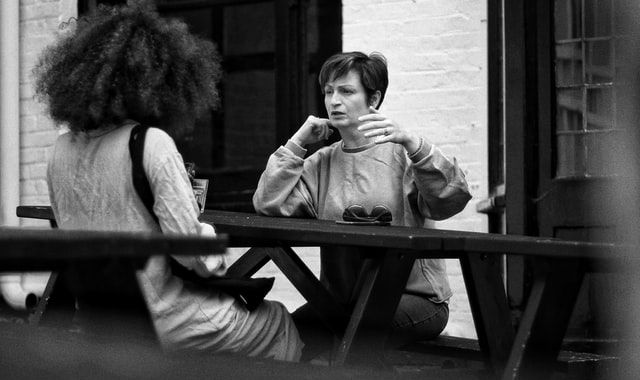Writing letters in a 'Conversational Style' ?

Comments in some good Forum Topics
....can bring up great ideas.
For example, this one, posted on our Slowly subReddit by LoseFirst00, asked :
My letters average around 800-900 words and that’s me saying a lot. What do people who write 2000-4500 words actually say in a letter?
Like how do they fill up so much content. It makes me feel so boring not being able to reach that word limit
Which received an excellent reply (by Spassus)
Usually just a lot of topics being discussed at the same time. Also telling personal stories relating to some question or topic can get pretty long as well.
But you shouldn't try to inflate the letter for the sake of length, nor should you feel bad about not writing super long letters :) Often times less is more.
And others chimed in as well
From the original topic poster, averageineverythin :
Better advice than this doesn't exist !
...who appreciated Spassus's comment. As did I. ?
Also added my own comments
Here, starting with a small quote from one of topic's responses.
we just keep talking about the previous topic in details like you will talk in a real life conversation and not end a particular topic and add a new thing each letter.
Yes, that's it – I use the same 'conversational style' when writing my letters, and enjoy doing it. The text flows, and the readers are usually pleased with them.
I write in the same way that I would be phrasing things, if I was chatting with a friend sitting in the sofa here, right across from me.
And I am not a big fan of the 'Questions and Answers' format, which can be time consuming for the recipient.

Conversational Style when writing letters ?
My comment above generated a reply by LilKittyWinks with some good questions – and I thought of collating this topic so more of our SLOWLY users can see them. I think they are important, maybe helpful?
Can you explain more about this writing style?
Yes, I can.
The basic idea is to write the text like if you had the other person sitting near you. Think a relaxed setting, I usually write on the sofa on my living room, and I would imagine the reader as a quiet listener; sitting in the loveseat across from me, or one of the other chairs.
My writing is intended to register how I would tell them the story, or news, or situation that my letter is describing.
Did a quick search and found some good suggestions in this article: '7 Tips for Writing Conversationally', copied here for you.
7 Tips for Writing Conversationally
Good conversational writing creates an immediate connection and doesn’t waste your reader’s time.
- Pay attention to the way people speak. Your goal is to sound like a real human being having a two-way conversation, not a piece of anonymous academic or business writing. A real person uses contractions, speak in fragments, and use reflexive pronouns like “I” and “we.” While this may go against the grammar rules you picked up in a high school writing class, this works best for conversational writing because this is how we talk. (Try to avoid filler words like “uhh” and “umm.”)
- Write in short sentences. When it comes to readability, shorter tends to be better. We don’t often speak in long monologues, and long sentences run the risk of losing the thread. Focus on getting to the point, and avoid writing paragraphs with more than four or five sentences.
- Watch out for the passive voice. Passive voice is when the subject doing the action is the object of the sentence. That is, writing something like “The ball was caught by the dog” rather than simply “The dog caught the ball.” See how the first version, which is written in the passive voice, sounds clunky and awkward? In your conversational writing, try to use the active voice—make sure that the thing doing the action is the subject of your sentences.
- Develop your own voice. As a writer, it’s important to develop a sense of your own speech rhythms and vocabulary. What words do you tend to naturally use, and which do you avoid? If you aren’t sure what your voice sounds like, try keeping a casual journal or blog for a few weeks, and then go back read your own blog. Your most natural, conversational tone is the one you use with yourself.
- Read your writing out loud. Reading your work out loud will help you determine if your writing flows in the same way that you speak. You might notice that you use words you don’t normally say, or that you cram too many ideas in. Read your first draft out loud and pay attention to where you pause for breath—if your breaths fall in the middle of a sentence, these are excellent points to stop and rewrite. Find David Sedaris's tips for improving your writing by reading aloud here.
- Know your audience and your situation. Who is your target audience? Are they young music fans, or elderly mystery novel aficionados? There are different kinds and degrees of informality, and the right note to strike will depend on who you’re writing to. Part of developing your writing skills is knowing how to write to different groups as though you were a member of that group.
- Know when a little formality is appropriate. Even if most of your writing is more conversational in style, there may still be times when a little formality is called for. For instance, when writing about subjects where the reader may be looking for guidance—like financial, legal, or medical information—you’ll want to strike a more professional tone to show that you’re trustworthy.
Source : Masterclass.com, How to Write Conversationally – 7 Tips for Writing Conversationally

LilKittyWinks also had other questions...
She also asked :
Do your conversations on certain topics never really end then? Do they just dwaddle off? I'm currently writing around 1k long letters but I feel like it's disappointing and short for my pen pals.
The conversations could change directions, as each letter is a response to the other person's. We react, and respond to things they mentioned in their letters, new developments, perhaps, which you feel like commenting on.
We don't need to keep the same topics open in all letters, the contents are dynamic.
Read and reply immediately
I like to read their new letter and respond to it immediately. I feel this is the best response I can provide, as the impressions their letter caused are fresh and my response writing flows easier with these impressions being really lively.
Really fear reading various letters and then having 10 of them accumulated, lots of pending replies to be written. A bad idea, I imagine it would become a chore them as the original impact has worn off, the memory of the letter content might have dimmed. I would need to re-read the letter before I could even try to reply.
So, I find it more productive to just avoid this all together – by sticking to my own rule of 'reading only if I am ready and willing to write a reply, right after'.
Ideal letter size ranges?
I find the 1,000 Words size perfect, it's my goal when writing a letter to a pen pal friend who uses the Slowly web client. If I know the other person is a mobile device user, they would probably be better off with a shorter, easier to read and reply letter – in this case I reduce my goal to 500 Words.
The word count is a guideline, when I am deep in a letter I don't look at the count unless I think it might be getting long – which happens in fact. If that is the case, I will mention the length and send my final greetings, close the letter and send it.
So — 1,000 word letters are not short, they are a good size for a lot of people, they can convey a lot. Write longer if you feel like it, and if both you and your penpal don't mind the time it takes to process at each end.
Hope this helps! ??
Famous Last Words
Banner image, photo by Priscilla Du Preez on Unsplash. Friends image, photo 2 by Metin Ozer on Unsplash. Friends image, photo 3 by Etienne Boulanger on Unsplash
Special thank you to all the folks behind the SLOWLY app.
Letters we share, with pen pals all over the world. A modern day take in the traditional penpal experience. Come and join us, using SLOWLY.
Follow Blog via your Fediverse/Mastodon account :

@friends-near-and-afar-letters-we-share@wordsmith.social
This page created in MarkDown language. Thank you for reading, feel free to comment, via a direct message to my Twitter account – or the Reddit one.
You can also post a public comment in the Reddit thread for it here.
 yann2@bsky.social
yann2@bsky.social